#Arthur Leicester
Explore tagged Tumblr posts
Text
i feel like ep 20 has rewired my fucking brain like oh i guess it's ok to mourn, i guess i want to keep fighting like a stubborn little cockroach, i want to love and depend on others, i guess it is the leftover love that carries me forward. oh my god
#i try not to think about my mum#i like to think i built myself in spite of her not because of her#but i guess i carry her with me anyway#Jesus Christ#i hate my dad sometimes#but i love that man too and i carry that with me#every time i cook#speak bangla#wash the dishes#play guitar#i make choices with them in mind#my fuckass dad and my dead mum#and that's ok i guess#it's ok to love them#it's ok to feel#god damn#malevolent#malevolent ep 20#Arthur malevolent#Arthur Leicester#anyone who knows me irl pls ignore the tags#or don't its up to you
12 notes
·
View notes
Text
I started typing Arthur's surname as "Leicester" as a joke but now unironically I type Leicester whenever I write about him help
#arthur lester malevolent#arthur lester#british twink arthur#malevolent#someone else say they also call him orthur leicester *praying emoji*
7 notes
·
View notes
Text
The only thing they killed was that name. He goes by JOHN DOE now and he is a TRANS ALLEGORY ICON ‼️‼️‼️
“Sir, I suggest we leave the humans alone. Because they killed an elder god. No sir, not ‘some little bullshit local god.’ Hastur, sir. The King in Yellow.”
5K notes
·
View notes
Note
yes pls.... give inform....
so!! gray was originally a character i wrote and designed for a narrative project, not actually lancer.
his original concept was meant to open the discussion "how much of gray is himself/his own nature, and how much is TR-GRAE; and vice versa?" though, honestly, that doesn't matter much to me; he just, is the way that he is. i actually refer to the two as brothers, though they're less like a traditional family and more two people shoved into a blender, combined, then poured back out into two separate molds?
anyways, about why gray is so jacked up!!
From his original text, I kept the city/colony he originates from;
>The collapse of Leicester (pop. 1,230,000) marked the final days of Harrier (55-Cancri-fb)'s civilization. Colonization of the distant moon had been difficult; Tidally locked and weaving ever-so-slightly in and out of the solar system's habitable zone, the celestial body only had two small islands of land that were habitable year-round. Capitalizing on the mineral-rich and lush land, Harrier's settlers built and developed massive supercities. Housing, commercial districts, etcetera were all crammed together in compact skyscrapers. This left more room for agricultural efforts, but created a cramped and uncomfortable lifestyle for the generations to come.
Eventually- Leicester, the largest of the two habitable cities, began to grow too close to the stars. Generations of expansion made the terrain beneath their feet unstable- and the crumbling body of their beloved moon gave way. The entirety of Leicester collapsed in on itself, sucked into a massive sinkhole. Skyscrapers fell unto one another like a poorly-assembled jenga tower. Survivors were few and far in-between as decades of carefully-constructed infrastructure fell into the depths. Those who did survive were forced to contest with the post-apocalyptic like conditions of their fallen city.
So, Gray, bless his heart, is dropped into the sinkhole with the rest of his city; Most of the scars we see today, such as the ones on his chest and (organic) arms, are the result of shrapnel damage. He loses his left arm in the initial collapse, and his right to infection shortly thereafter;
One unfortunate soul- seven year-old-boy, Arthur- fell into the custody of the paltry few that had been living on the lip of the city. Wounded from the collapse of his housing unit, the boy's arms were tragically amputated; Quick thinking and good luck, however, saved his life. Shortly thereafter, he was outfitted with makeshift prosthetics, allowing him to at least somewhat participate in the survivors' attempts at rebuilding.
Now, that's the spot where Original Gray and Lancer Gray diverge; in LANCER, the very young Gray goes on to explore and adventure in the wreckage of his city, and eventually comes across the entombed chassis of a long-forgotten mech. He climbs up to meet it- and makes contact with the cascading mind of a very, very old NHP.
See, my take on NHPs' "perspectives", and how those can be translated into human/anthropocentric analogies, is sort of convoluted and it would honestly require a post of my own (which I would love to make, if given the time and motivation)- but the important thing about how TR-GRAE (or, at least, the nonhuman mind it was founded on) in specific works is that a willing, malleable, and open (y'know, like a child's) human mind was the perfect means for it to ground and voluntarily shackle itself.
Obviously, gray doesn't remember this. He doesn't remember much of his history at all.
No, Gray remembers emerging on Carina, well into his teens, having been "adopted" by a Northstar campus outreach/scholarship program based on engineering prowess he thinks that he always had. He doesn't remember how, or when, but he had built a casket for the mind that he discovered, and had come to regard the entity- the person- within like family. Gray and TR-GRAE (named for the chassis he was discovered in and the subsequent role he filled in their community, "Terran Recovery - Ground Rescue and Excavation") understand eachother on a frightening level, even without implant intervention (though Gray has a lot of implants installed for his and his copilot's convenience). They don't need to speak to know what the other is thinking, or needs, or even knows. Of course, there are several divides, and the fact that TR-GRAE knows what Gray knows, but not vice versa—
Anyways, Gray has been in IPS-N "custody" for ~8 years? He was 8 when the city collapsed, 10 when they picked him up, and he's 19 now. Ra's sake, he's young—
I hoped you paid attention, this will be on your test.
#i left out a lot#like how he built his own prosthesis to look like the vlad's or how he designed tr's vlad-based chassis himself#or how much of his body is actually augmented/metal and why#but i don't like long posts or typing formally...#lancer#lancer rpg#lancer oc#if someone wants the NHP post id be willing
20 notes
·
View notes
Text

Portion of 'Leicester' wallpaper, scrolling acanthus leaves with an underlay of smaller flowers and foliage (including carnations), with a dark ground; Print on paper; Designed by William Morris; Produced by Morris & Co.; Reprinted by Arthur Sanderson & Sons Ltd.; England; ca. 1955. | Source
114 notes
·
View notes
Text
Here is Day 2 of 12 Days of Arthur: Music 🎶
Just a fluffy little scene 🥰
A thank you again to @oigimi and @scummy-writes
Arthur fluff, ~480 words

It was a late start to the day, but Arthur supposed that was simply the price of being an author. After a mighty stretch, he braved the hallways to procure some coffee.
Gleaning from the sun rays filtering in through the windows, he reckoned it must be a bit past noon. A smile graced his face, knowing she would be in the kitchen at about this time. A chipper hum flowed through him.
Taking a brief pause just before his entrance, Arthur’s smile grew wider as he heard the quiet shuffle of feet beyond the door. He froze then, becoming even more grateful that he’d taken the time to listen in.
Within the kitchen, her voice took up a small tune; she was singing the very tune that he had finished just a moment before.
♪ “Goodbye Piccadilly, farewell Leicester Square~ It’s a long, long way to Tipperary, but my heart’s right there.” ♪
There was a strange flutter in his chest, followed by a warmth he’d long grown disaccustomed to. Had the two of them been on the same wavelength? Arthur found himself liking the idea of that. Why, he’d liked that idea far too much.
Not so fond of the idea of waiting any longer, Arthur made a far more excited entrance than he’d initially planned.
“Why, I didn’t know you were a songbird! You should have told me, luv,” Arthur’s lilted voice made her jump, but she turned toward him with a shy smile.
“You’re waking up rather late today,” she teased.
“A writer’s work is never done, I'm afraid. We simply rest our eyes for a few hours here and there until we can fuel up on coffee made by beautiful morning birds.”
Her cheeks were determined not to grow any pinker, but it was a challenge. She brought up a cup and began brewing.
“Speaking of…” Arthur stifled his enthusiasm as he broke the brief silence. “I would have thought the only music you and I would both know would be one of Wolfie’s. I’d never imagine you’d know It’s A Long Way to Piccadilly.”
She chuckled, “I’m actually pretty sure Mozart’s pieces are the only songs we both knew.”
Arthur blinked, puzzled. “But you were just singing it word-for-word?”
Her eyebrow raised as she wrapped up her coffee preparations. “Arthur, you sing that song practically every day. I’ve picked up the words pretty quickly from it,” she giggled. “I used to think it was just when you were at your happiest, but really it’s just all the time,” she grinned, handing over his cup.
Bugger me... There went that damned fluttering again.
“No, luv, I think you were spot on. I think the amount of happy days have simply grown exponentially as of late.”
“Oh? Well that’s good!”
Arthur nodded, the warmth within him threatening to combust. “I think so, too.”

Writing Masterlist
Border
#12 days of arthur#tick tock it’s loving Arthur o’clock#Arthur my beloved#ikevamp arthur#ikemen arthur#ikevamp#ikemen vampire#moth’s writing#scheduled
37 notes
·
View notes
Text

Queen Elizabeth II meets with Maggie Smith and Sir Laurence Olivier at the premier of 'Othello' at the Odeon Leicester Square on 2 May 1966.
📷: Arthur Sidey / Mirrorpix / Getty Images

Queen Elizabeth II chats with Dame Judi Dench and Dame Maggie Smith at the Royal Film Performance of 'Ladies In Lavender' at The Odeon Cinema in Leicester Square on 8 November 2004.
📷: Tim Graham Photo Library via Getty Images

Prince Charles speaks with Maggie Smith at the Pride of Britain Awards at the Grosvenor House Hotel on 31 October 2016 in London, England.
📷: Adam Gerrard - WPA Pool / Getty Images
#Queen Elizabeth II#King Charles III#British Royal Family#Dame Maggie Smith#Maggie Smith#British icon#British actress#actress#rest in peace#Dame Judi Dench#Sir Laurence Olivier
10 notes
·
View notes
Note
What’s a dream role you’d cast David Oakes in if you were given the choice? 👀
i've always said that david should play robert dudley, the earl of leicester, because one thing about robbie is that he will always remain ambiguous. did he really love his wife amy robsart? was he the one who arranged her death to have the possibility of marrying the queen? also, did he really love elizabeth or did he just use her fondness for him to climb to the top? there are so many question marks all over robert, especially when his family all got executed for treason. he's also dashing, ambitious, sometimes ruthless yet passionate and intelligent. david oakes is 100% the type of character to play this role since he can add so many layers to this possibly morally gray persona and make him as humane as possible <3 (with natalie dormer playing elizabeth and holliday grainger playing amy robsart-dudley)
i also wanna see david play either arthur morgan or john marston because...well? bro loves the game lol
#i miss his pretty renaissance face on my screen can he just come back??#vikings valhalla season 3 hurry tf uppppp#david oakes#robert dudley#red dead redemption 2#anon messages#anon
12 notes
·
View notes
Text
Edmund Dulac's Fairy Tales go to War
Jstor Daily published an article with the catchy title "Edmund Dulac's Fairy Tales go to War". Of course I had to read it. The original article is here if you want to check it out, but I'll still copy-paste it below because it's crazy info. (And given it is quite long I will put two thirds of it under a cut)
Edmund Dulac’s Fairy Tales Go to War One of the best-known illustrators of the “golden age of children’s gift books,” Dulac was also a subtle purveyor of Allied propaganda during the Great War.
By: S. N. Johnson-Roehr and Jonathan Aprea ; December 16, 2022
Once upon a time, there was a young artist named Edmund Dulac, who built his early reputation on his illustrations for J. M. Dent & Company’s 1905 edition of Jane Eyre. Almost instantly, he became a leading name in the book arts, producing illustrations for the Brontë sisters and popular magazines. Annual exhibitions of his drawings and paintings at the Leicester Galleries, London, drew the attention of both the European and American art world. In 1910, critic Evelyn Marie Stuart, writing for Chicago’s The Fine Arts Journal, described his work as “rich with poetry and imagination, and strong in the possession of that decorative element which renders a picture universally pleasing.” His drawings were like "things seen in a vision or a mirage; or traced by the fancy of a child in the lichens on the wall, the water discolorations upon a ceiling, or the light shining through a broken crumpled shade; or, even like the things we try to decipher in the leaping flames and glowing embers of an open fire—many of these delightful sketches suggest to our fancy in some detail a variety of objects."
Dulac’s themes tended toward the fantastical—scenes from the Arabian Nights and Omar Khayyam’s Rubáiyát—with roots in the Pre-Raphaelites and not far removed from the work of Arthur Rackham and Kay Nielsen.
Born in France and naturalized as a British citizen in 1912, Dulac understandably awarded his loyalties to the Allies during the Great War. To support the war effort, he contributed his art and design skills to several charity books, including Princess Mary’s Gift Book and King Albert’s Gift Book, both published in 1914. If there remained any doubts as to his feelings about the Axis powers, they were surely erased when he published Edmund Dulac’s Picture-Book for the French Red Cross in 1915, with its cover proclaiming “All profits on sale given to the Croix Rouge Française, Comité de Londres.”

Even more convincing—and more inventive—was his use of fairy tales to not just further his charitable efforts but to possibly encourage the United States to join the war. Published in 1916, Edmund Dulac’s Fairy-Book was a subtle but persuasive example of wartime propaganda. Subtitled “Fairy Tales of the Allied Nations,” it included Dulac’s own adaptations of folk tales gathered from the nations fighting with Great Britain: France, Russia, Italy, Belgium, Serbia, Japan, and China.
Below, courtesy of the Minneapolis College of Art and Design, are reproductions of some of the illustrations from Edmund Dulac’s Fairy-Book, accompanied by brief explanation of each story.

Snegorotchka: A Russian Fairy Tale
Snegorotchka (more commonly transliterated Snegurochka), the “The Snow Maiden,” is a recurring character in Russian folklore, playing various roles, from child to adult, in stories bounded by the winter and spring seasons. By the late nineteenth century, Snegurochka had blended fully with the traditions of Christmas, often serving as a helper to Grandfather Frost (Ded Moroz).
In Dulac’s version of a common tale, Snegurochka is a girl made from snow, brought to life to add joy to the waning years of a childless couple. An elderly man and women all but will the girl into being as they shape a tiny body of snow in the woods. Snegurochka leaps to life, filling their home and souls with warmth throughout the winter. Tragically, the little girl disappears with the heat of spring weather, leaving the parents bereft.
Another version of the Snegurochka tale formed the basis of a play by Alexander Ostrovsky, which was subsequently adapted into an opera by Rimsky-Korsakov.

The Buried Moon: An English Fairy Tale
Sometimes known as The Dead Moon, The Buried Moon highlights the dangers of living in the bog country of Northern Europe.
Traveling through a bog, a personified Moon becomes entangled in magical, malevolent branches. After some struggle with “all the vile things” that love darkness (witch-things, bogle-bodies, creeping things, and the Scorpion King, to name a few), the Moon finds herself buried deep in the mud, held down with a black stone.
Of course the humans miss the Moon, lamenting her failure to appear in the sky on schedule, but who even knows where to search for her? Even the Wise Woman of the Mill can’t see any trace of her. Fortunately, just before her entombment, the Moon had managed to briefly shine her light to guide a lost and wandering human out of the treacherous marsh. Remembering this moment, the man spreads the word. Emboldened by the Wise Woman’s words of encouragement as well as the Lord’s Prayer, the local people march to the bog, fight off the Horrors of the Darkness, and rescue their beloved Moon

White Caroline and Black Caroline: A Flemish Fairy Tale
Folklorist Antoon Jozef Witteryck collected White Caroline and Black Caroline (Wit Karlientje en Zwart Karlientje) and included it in his 1899 Old Flemish Folktales (Oude Westvlaamsche volksvertelsels), an annotated version of which was republished by Hervé Stalpaert in 1946. The story can also be found in the Annales de la Société d’Emulation pour l’Étude de l’Histoire & des Antiquities de la Flandre (Bruges, 1889).
White Caroline and Black Caroline depends on the familiar figure of the evil stepmother, a woman who loves her ugly daughter (Black Caroline) more than her beautiful stepdaughter (White Caroline). Everyone and everything, from townspeople to lambs to dancing dogs, love White Caroline and equate her beauty with good. But the mother prefers her own daughter, noting “Black Caroline was so ugly;—but she was good all the same!”
And indeed, Black Caroline is good. Her mother tries no fewer than three times to murder White Caroline, and each time, Black Caroline intercedes. Poison thorns in the pillow, poison in her meatball dinner, an “accidentally” falling millstone—none manage to kill White Caroline, thanks to Black Caroline’s quick thinking.
The abrupt entrance of White Woman, queen of all the water and the woods, brings the murder attempts to a close. Not surprisingly, White Woman also loves White Caroline and promises to give her whatever she wishes—beautiful grapes, a dress of silk, a nice sailboat. Luckily, White Caroline is also good: she wishes to have Black Caroline with her. More than that, she wishes they could look alike. The White Woman has an idea:
“Little white feathers appeared on their shoulders and spread until they were entirely covered; and there they stood together, two beautiful white swans! And ever after they swam up and down on the peaceful water and no one could tell one from the other.”
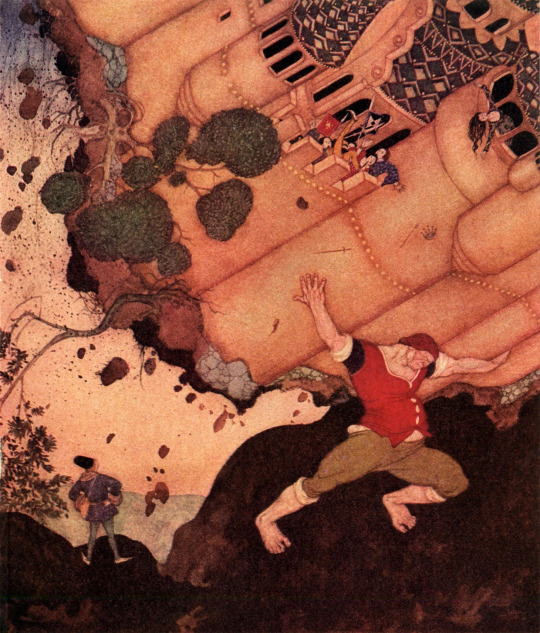
The Seven Conquerors of the Queen of the Mississippi: A Belgian Fairy Tale
While there may be an actual fairy tale underpinning The Seven Conquerors of the Queen of the Mississippi, the story’s title reveals Dulac’s probable agenda. It takes no large leap of the imagination to read the “seven conquerors” as Great Britain, France, Russia, Italy, Serbia, Japan, and China, all seeking an alliance with the Queen of the Mississippi—the United States—on the fields of Belgium.
The story is straightforward and structurally repetitive—each conqueror swears an oath of loyalty, and their individual strengths combine to win the Queen and kill the King (hello, Kaiser Wilhelm II).
Dulac, or some unnamed collaborator, has penned a verse that cuts through the first half of the tale with a modern rhythm and vocabulary.
“Will you travel with me, my pippy?” “Oh! Whither away? To Botany Bay?” “But no; to the far Mississippi, Where a Queen—tooral-ooral-i-ay— Is waiting for what I’m to say.” “I am yours! And the bounty?” “Either here or in Botany Bay!”
‘Will you travel with me, my pippy?” “Oh! Whither away? To Rome or Pompeii?” “But no; to the far Mississippi: There’s a Queen of great beauty that way, And there’s no one but Cupid to pay.” “I am yours! And the bounty?” “Name your price: it shall be as you say.” And so on. Travel with me, my pippy!
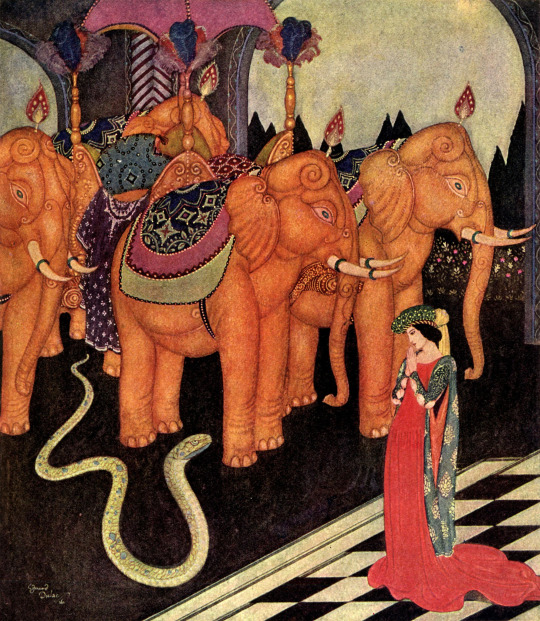
The Serpent Prince: An Italian Fairy Tale
The Italian poet Giambattista Basile collected The Serpent Prince (sometimes translated as The Enchanted Snake) in the seventeenth century, including it in The Pentamerone: Lo cunto de li cunti (The Tale of Tales). Folklorist Andrew Lang drew upon Basile’s version for The Green Fairy Book (1892).
Dulac has created his own prefatory material for the familiar story, opening with the popular nursery rhyme:
The old woman who lived in a shoe, Who had so many children she didn’t know what to do,
allegedly “lived about the same time in another part of the country” even though The Serpent Prince was collected in Naples.
As the story goes, a forester’s wife, Sapatella, finds a tiny serpent in her firewood. Childless, Sapatella is startled but amenable when the serpent offers himself up for adoption (“she was a kind-hearted woman and very, very lonely”).
The serpent grows—as children do—and soon demands a wife. And not just any wife! The serpent must marry the king’s daughter. Surprisingly, the king agrees to meet this demand. Or does he? He will give his daughter in marriage only if the adopted son-serpent can turn all the fruit in the royal orchards to gold.
It’s not clear why anyone is surprised that a talking serpent can wield the magic necessary to turn fruit into gold. Nor is it clear why the king would think the serpent would fail at any additional challenge placed before him. Turn the walls into diamonds and rubies? No problem. Turn the entire palace into gold? Absolutely (“not gold plate either: it was all solid gold of the purest kind.”). The king is forced to cede the battlefield. The princess will marry the serpent.
Of course, the serpent is really an enchanted prince, and here you would think the story would end: the affianced are wed, their kingdoms allied. But thanks to an additional foolish act by the king, the prince is again enchanted (and worse), and only the princess can save him. But will she be able to outwit the wily fox standing between her and her beloved?
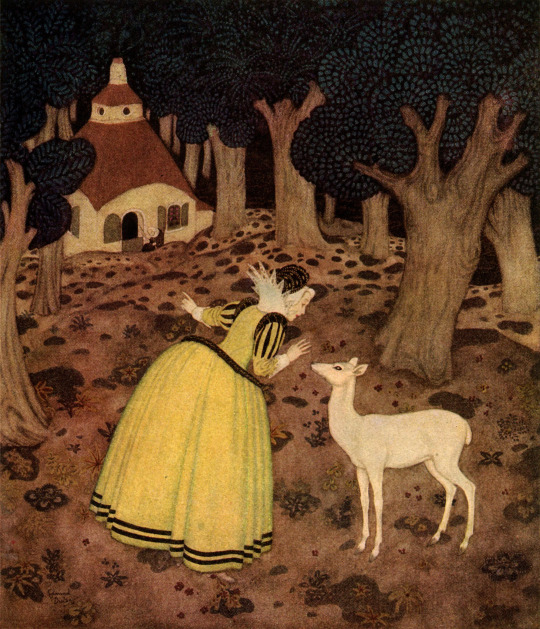
The Hind of The Wood: A French Fairy Tale
Dulac offers a faithful retelling of The Hind in the Wood (La Biche au bois, also translated as The White Doe or The Enchanted Hind), written by Marie-Catherine Le Jumel de Barneville, Countess d’Aulnoy. A talented and creative storyteller, Countess d’Aulnoy gave us the very words “fairy tale” in 1697, when she published her first collection under the title Les Contes des fees (Tales of the Fairies).
Though the titular hind is the star of the story, the scene opens with an unhappy, childless queen encountering a talking crayfish. Though “hearing a big Crayfish talk—and talk so nicely too—was a great surprise to her,” the queen listens carefully to the crustacean.
The reward for her attentiveness is a kingdom transformed. Beneath her feet appears “a carpet of violets, and, in the giant cedars above, thousands of little birds, each one a different colour, [singing] their songs; and the meaning of their melody was this: that cradle, woven by fairy fingers, was not there for nothing.” Soon she will be a mother!
A troupe of fairies gather around the suddenly expecting queen and ask that she welcome them on the day of birthing so they can give special gifts to the babe, who will be named Désirée. And on that special day, the queen indeed remembers to bid them come to the palace. Sadly, she neglects to invite the talking crayfish (who is really the Fairy of the Fountain) to the celebration.
Curses. But only small ones, in the scheme of things. The Fairy of the Fountain warns the royal parents to keep Princess Désirée from seeing daylight until she turns fifteen. That’s all.
Alas, the Warrior Prince lies on his death bed. Just a portrait of Désirée is enough to make him fall in love and abandon his plans to marry Black Princess. Yet he cannot see her—she will not be fifteen for a few more months. To save the Warrior Prince, Désirée agrees to travel with her two ladies-in-waiting by darkened carriage to his kingdom.
Unfortunately, one of those ladies-in-waiting, Long-Epine, is a traitor. She slits the cover of the carriage, exposing Désirée to daylight. Just a drop of sunlight turns the princess into a dazzling white hind. She instantly runs off into the forest. And that is the curse: by day, a doe; by night, a lonely princess.
The Warrior Prince wanders this very forest and soon spots the white deer. Annoyed that the animal tries to keeps its distance from him, he looses an arrow and pierces her flank. He’s sorry! Especially when he finds out the hind is his beloved, enchanted.
She isn’t enchanted for much longer, however. The Prince, even knowing all, loves her. And that is enough to break the spell
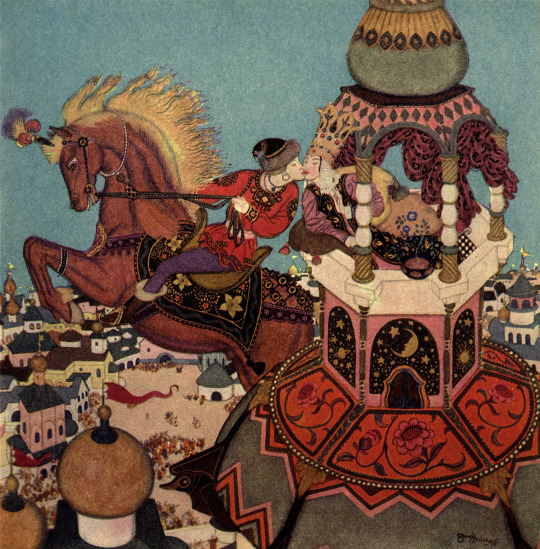
Ivan and the Chestnut Horse: A Russian Fairy Tale
Variations of Ivan and the Chestnut Horse are abundant in Russian folklore. Sometimes Ivan rides a chestnut horse, sometimes a dun. A common version of the story, known as Sivko-Burko, was collected by A. N. Afanas’ev in the mid-nineteenth century. Included in Jack V. Haney’s comprehensive The Complete Folktales of A. N. Afanas’ev (Tale #179, Vol. II), this version gives Ivan a magic black steed.
Ivan and his brothers have just committed themselves holding daily prayers over the grave of their recently departed father when they hear that Princess Helena the Fair has decided to wed. To win her favor, her suitor must leap on horseback to the top of the shrine on which she sits, kissing her as he flies through the air.
Ivan, the youngest of the siblings, offers to take on the burden of graveside prayer for a week so his brothers can curl their hair and train their horses for the challenge. One week stretches to two, and then to three. The brothers ignore their filial duties to dye their mustaches. So much attention is paid to their appearance that they even neglect to feed their horses.
And yet, when the day of the leaping contest arrives, the older brothers dash away on their mounts, leaving Ivan alone to pray and weep over his father’s grave.
It was thus that two out of three brothers miss their father’s resurrection. Shaking himself free of the damp earth, the father offers to help his youngest son. He begins to call out in a loud voice—one time, two times, three times. Ivan discovers his father is summoning a beautiful chestnut horse!
Yes, this is the enchanted steed that will take Ivan to the shrine of Helena the Fair, where—after two failed attempts—it rises to the leap, allowing Ivan to press his lips to those of the princess “in a long sweet kiss, for the chestnut horse seemed to linger in the air at the top of its leap while that kiss endured.”
After summoning the steed, Ivan’s father immediately vanishes. No matter, because Ivan is soon welcomed to supper with the father of his bride, Princess Helena the Fair.

The Blue Bird: A French Fairy Tale
The Blue Bird (l’Oiseau Bleu) is another tale that comes to us by Countess d’Aulnoy. Though there are many variants of the story found across Europe, scholar Jacques Barchilon notes that d’Aulnoy’s version is remarkably robust, appearing in a French Canadian collection, “word for word the version of Mme d’Aulnoy’s with all details,” as late as 1960. Andrew Lang also included it in The Green Fairy Tale Book.
Our story opens with a rich but miserable king. He’s inconsolable, having only recently become a widower. Hoping to comfort him, his courtiers present him with a woman dressed in mourning clothes and possibly crying even louder and longer than the king himself.
Finding solace in their similar sorrows, they decide to wed. Each brings into the marriage a daughter from their first marriage. The king’s daughter: “one of the eight wonders of the world,” the young and lovely Florine. The new queen’s daughter: “neither beautiful nor gracious,” the young Truitonne, with a face like a trout and hair “so full of grease that it was impossible to touch it.”
The queen loves Truitonne much more than she loves Florine, which wouldn’t matter if the king didn’t love the queen so much that he cedes to her every wish. For instance, he allows her to dress Truitonne in jewels and Florine in rags when Prince Charming appears at court. Despite the heavy-handed costuming, however, Prince Charming only has eyes—and love—for Florine.
The queen schemes. The queen plots. She enlists maid, frogs (“for mind you, frogs know all the routes of the universe”), and fairy godmothers. And yet the Prince will not be deflected from his plans to be with Florine. Finally, exasperated with his stubbornness, Truitonne’s fairy godmother turns the prince into a blue bird—for seven years!
It’s not too bad, at first. In bird form, the prince finds it easier to woo Florine—until the queen discovers that he flies to her window every night. Wielding her dark magic, Truitonne’s fairy godmother sends the blue bird to his nest to die.
Fortunately, every bad fairy seems to be balanced by a good fairy. This bright character finds the dying blue bird in his nest and heals him. It doesn’t seem to help much—the queen is determined that Truitonne will marry the prince even if only by trickery and deception.
The queen’s shenanigans never seem to end—this is a long fairy tale—but eventually the universe, or at the least the good fairy, finds a way to bring Prince Charming and Florine together.

The Friar and the Boy: An English Fairy Tale
The Friar and the Boy, also known as Jack and his Stepdame, reaches back to the poetry of medieval England. In volume three of Remains of the Early Popular Poetry of England (1866), William Carew Hazlitt records a c. 1585 London imprint of the chapbook verse that underpins the modern version of this tale.
The story begins with Jack, a young lad wronged by his stepmother. She starves him, she yells at him, she altogether doesn’t care for him.
One day, sent to the fields to watch the sheep, Jack encounters a hungry old man. Jack’s lunch isn’t much, as his stepmother is loathe to feed him decent food, but he gives it to the stranger. In return, the old man gives Jack three wishes.
Wish one: a bow and arrow, charmed such that the target will never be missed. Wish two: a pipe, its magic strong enough to make anyone dance who hears its tune. Wish three: an enchantment that will turn his stepmother’s harsh words into laughter.
Jack instantly puts his granted wishes to work. When his stepmother begins to scold him, her words turn to laughter. She laughs herself sick. When the Friar is sent to chastise Jack for his impudence, he ends up dancing through the brambles to Jack’s piping. Soon Jack has the entire village dancing to his tunes!
Alas, his poor old father begs for a rest. Jack loves his father, so he ceases to play. Not surprisingly, the Friar takes advantage of the pause to have Jack called before the Judge, “be-wigged and severe.”
The Friar makes his case: “the prisoner here has a pipe, and, when he plays upon it, all who hear must dance themselves to death, whether they like it or not.”
Intrigued, the Judge asks to hear this so-called Dance of Death. Jack is happy to oblige and takes up his pipe to play. Soon everyone in court is on their feet, dancing madly to the tunes. Even the judge joins in, “holding up his robes and footing it merrily.” He’s a believer, but he soon asks the boy to stop.
Jack agrees, but only if everyone promises to treat him properly.
“I think,” says the Judge, “if you will put your pipe away, they will consent to an amicable arrangement.”
Court is adjourned.
The End.
#edmund dulac#fairytale illustrations#fairytale art#french fairytales#british fairytales#english fairytales#edmund dulac's fairy book#world war I#wwI#fairytales and war#fairytale propaganda#russian fairytales#belgian fairytales#flemish fairytales#edmund dulac's fairy-book#italian fairytales#political fairytales
11 notes
·
View notes
Text
I have been betrayed and lied to by the Penguin Classics Arthur Machen anthology 'The White People and Other Stories’ (Foreword by Guillermo del Toro).
This bastard. This one right here.
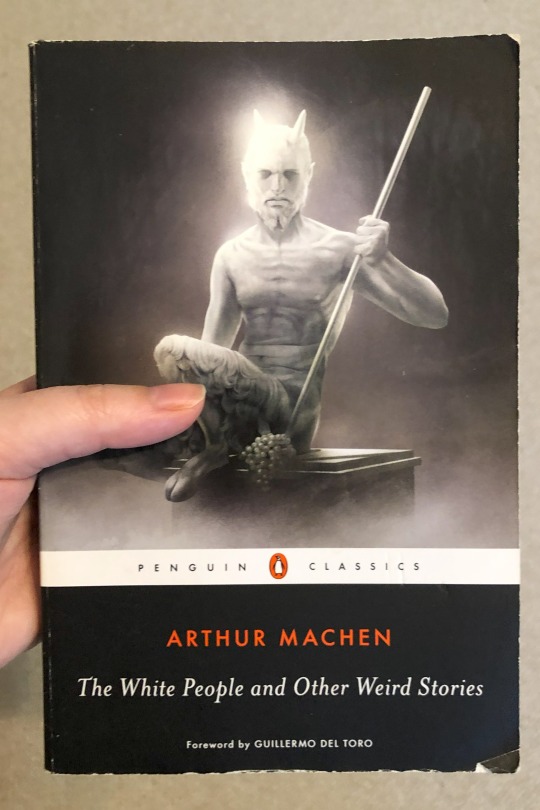
A foul deceiver.
For over a decade I have loved and cherished this volume. This and The Great God Pan have been my very best eldritch horror pre-Lovecraft saturation friends for years. So where lays the betrayal? What Judas lurks in these pages alongside the sinister satyrs and uncanny Folk hiding below the hills?
Miss Lally, narrator of “Novel of the Black Seal,” and Miss Leicester of, “Novel of the White Powder.”
‘What? That’s two different people, Arcane!’
But they’re not. They are one single insidious actress.
Specifically, the young lady known as Helen—no relation to the more imposing and inhuman Helen Vaughan of The Great God Pan—as shown in THIS:
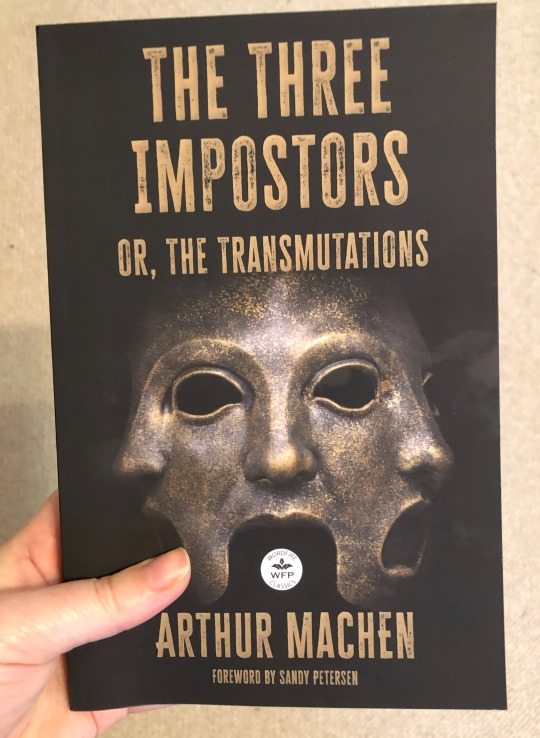
This skinny little sucker that I finally read so, so long after devouring the lovely anthology in which I got to enjoy the company of Misses Lally and Leicester respectively, thinking to myself: “How exciting! Non-wilting, non-sexy lamp female protagonists! Two of them, even! I bet Mina Harker and Miss Lally would be such good friends, bonding over writing and tragic martyring. :3 Miss Leicester, condolences on your goo-brother, I hope you sue the apothecary for every cent :3”
But no. No.
These ladies’ stories were both narrated by the SAME LYING LIAR trying to convince the 1.5 protagonists of The Three Imposters of her sob stories to wheedle them for info about some guy she and her fellow cultists are hunting for.
I fell for an imposter. I am a fool and dunce.
But at least she was the imposter who was the far superior storyteller compared to her cohort villains. There’s a reason Black Seal and White Powder are found in a short story anthology under their own power versus the guys’ lackluster orating. 'Ooh~ scary murder mountain gang~! Ooh~ I got robbed after ripping people off and being excruciatingly English about it, ooh~!' Get out of here. Let Helen work.
My one solace here is that, considering the nature of the content, the imposter-storytellers, and the fact that within TTI there are actual external proofs of the stories as real events that occurred, the Imposters really are exactly that. Imposters posing as the actual victims of the actual weirdness and/or evils described in the stories.
Which means that somewhere out in Machenland, the true Miss Lally and Miss Leicester and Mr. Henry Wilkins and (an admittedly unscrupulous) Mr. Frank Burton probably do exist…and got ripped off by a trio of sadistic plagiarists for the sake of a bafflingly convoluted ploy to wheedle strangers for information about their target. Bet they didn’t even get royalties >:/
#in which I whine about something 2.5 other people will care about#and become an object lesson for why you should always read stories in order#sigh#arthur machen#the three imposter#novel of the black seal#novel of the white powder
14 notes
·
View notes
Note
Hm... 14 for Arthur? He's been through so many different eras when travelling meant and required so many different things, so I wonder how that impacts his choice of dress when he's travelling today.
14.) Assign Arthur a traveling outfit
Brown leather oxfords, a grey Saville Row suit with a white shirt and green tie, with cufflinks and a tie pin that connects to his destination if applicable.
The most informal that man gets travelling internationally is a suit sharply enough to cut a decent Red Leicester. Usually with a coat over one arm. Seeing him in something like a tshirt has people a little weirded out if they don't know him well. Captaining ships half his life had a massive effect. Where clothing shaped authority and the right to authority, he's learned the art of dressing the part and he still performs it.
24 notes
·
View notes
Text
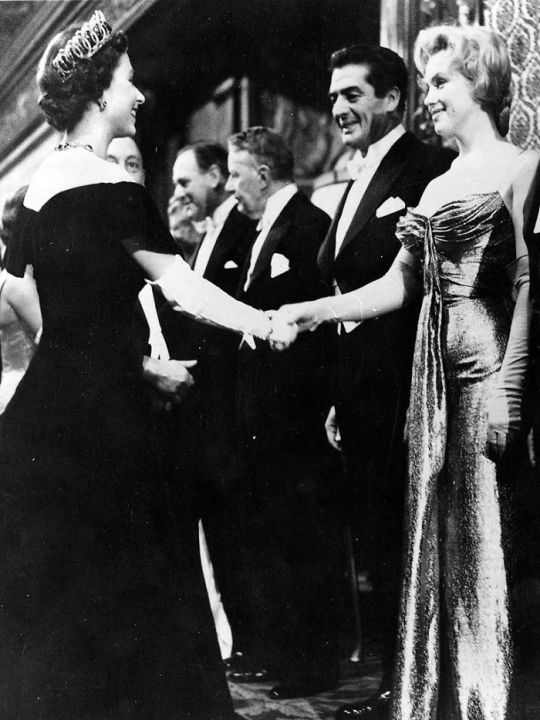
Her late Majesty Queen Elizabeth II meets Marilyn Monroe at the Royal premiere of 'Battle of the River Plate' at the Empire Theatre, Leicester Square London on 29 October 1956.
Marilyn was there to accompany her then husband Arthur Miller, fellow actor Victor Mature is standing next to her. Neither starred in the film.
Princess Elizabeth Windsor and Norma Jeane Mortenson were both born in 1926 - 42 days apart. (FTP)
8 notes
·
View notes
Text
"BLEAK HOUSE" (1985) Review
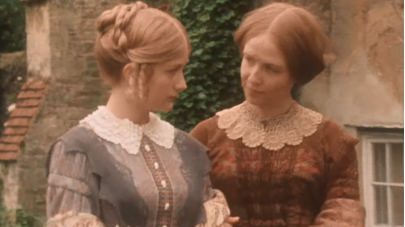
"BLEAK HOUSE" (1985) Review
In less than I year, I have developed this fascination with the works of Charles Dickens. How did this come about? I do not know. I have seen previous Dickens movie and television adaptations in the past. But ever since last year, I have been viewing these adaptations with a vengeance. And one of them turned out to be "BLEAK HOUSE", the 1985 adaptation of Dickens' 1852-53 novel.
Adapted by Arthur Hopcraft, this eight-episode miniseries conveyed the affects of Jarndyce v Jardyce, a long-running legal probate case involving the existence of more than one will. The heirs and their descendants have been waiting decades for the court to determine the legal will, for the sake of a large inheritance. Among those affected by the Jarndyce v Jardyce case are:
*John Jarndyce - a wealthy English landowner, who happens to be the proprietor of the estate, Bleak House. Jarndyce had inherited it from his uncle Tom Jarndyce, who had went mad waiting for a verdict on the case before committing suicide. *Richard Carstones - Tom Jarndyce's grandson and John Jarndyce's cousin, who also became one of the latter's legal wards, and a potential beneficiary of the Jarndyce v Jardyce case. *Ada Clare - Tom Jarndyce's granddaughter and Mr. Jarndyce's cousin, who also became one of his legal wards, and a potential beneficiary of the Jarndyce v Jardyce case. She and Richard, also cousins, became romantically involved. *Esther Summerson - one of the novel's main characters and orphan, who became Mr. Jarndyce's ward following the death of her previous guardian, Miss Barbury, who had also been her biological aunt. She joined the Bleak House household as Ada's companion and Mr. Jarndyce's housekeeper after he became the guardian of Richard and Ada. *Honoria, Lady Dedlock - the wife of baronet Sir Leicester Dedlock and a beneficiary of the Jarndyce v Jardyce case. She is also the younger sister of Miss Barbury and Esther's illegitimate mother. *Captain John Hawdon aka Nemo - a former British Army officer, who became an impoverished law writer and drug addict. He is also Lady Dedlock's former lover and Esther's illegitimate father. His penmanship on one of the Jarndyce v Jardyce affidavit attracts Lady Dedlock's attention. *Mr. Bill Tulkinghorn - Sir Leicester's ruthless lawyer, who noticed Lady Dedlock's reaction to the affidavit. This leads him to investigate her past and possible connection to Hawdon aka "Nemo". *Miss Flite - An elderly woman living in London, whose family had been destroyed by a long-running Chancery case similar to Jarndyce v Jarndyce. This has led her to develop an obsessive fascination with Chancery cases, especially the main one featured in this story. She quickly befriended Esther, Richard, Ada and Mr. Jarndyce.
As one can see, these characters represented plot arcs that connect to the Jarndyce v Jarndyce case. As one of the beneficiaries of the Jarndyce case, Richard becomes obsessed with the verdict. He seemed more interested in depending upon the Jarndyce verdict to provide him with an income rather than pursue a profession. This obsession eventually led to a clash between and Mr. Jarndyce, who has tried to warn him not to get involved with the case. Another clash formed between Lady Dedlock and Mr. Tulkinghorn, due to his determination to find proof of her past with Nemo and the conception of their child. A clash that proved to create even more damaging for a good number of people, than the one between Mr. Jarndyce and Richard. In the midst of all this stood Esther, who served as an emotional blanket for several characters - especially the inhabitants at Bleak House, a potential romantic figure for three men (ironic for a woman who was not supposed to be a great beauty), and the center of the Lady Dedlock-Nemo scandal.
For years, 1985's "BLEAK HOUSE" had been viewed as the superior adaptation of Dickens' novel. The first novel aired back in 1959. But a third television adaptation that aired in 2005 had managed to overshadow this second adaptation's reputation. But this is not about comparing the three adaptations. I am focusing only the 1985 miniseries. If I might be blunt, I believe screenwriter Arthur Hopcraft and director Ross Devenish created one of the better Charles Dickens I have personally seen. Granted, one might use the source material - the 1952-53 novel - as the reason behind the miniseries' top quality. But I have seen my share of poor adaptations of excellent source material . . . and excellent adaptations of poor or mediocre novels and plays. And I would find this excuse too simply to swallow. Hopcraft and Devenish could have easily created a poor or mediocre adaptation of the novel. Fortunately, I believe they had managed to avoid the latter.
With eight episodes, Hopcraft and Devenish did an excellent job in conveying Dickens' exploration into the chaos of the legal landscape in 19th century Britain, especially cases involving the Chancery courts. One might consider the longevity of Jarndyce v Jarndyce rather exaggerated. However, I speak from personal experience that an extended length of time in such a case is more than possible. But what I thought the effect of Jarndyce v Jarndyce and similar cases in Dickens' story seemed very interesting. In Richard Carstone's case, I suspect his own hubris and upbringing had allowed the case to have such a toxic effect upon him. He had been raised as a gentleman. Which meant he was not expected to work for a living. But since he did not possess a fortune or an estate - like Mr. Jarndyce - Richard never lost hope that the court would rule the Jarndyce v Jarndyce case in his favor, allowing him to inherit a great deal of money. Although it took another case to send Miss Flyte mentally around the bend, I found it interesting that her obsession with Chancery cases led her to attach her interest to the Jarndyce case beneficiaries.
The Jarndyce case also produce a group of leeches in the forms of attorneys like Mr. Tulkinghorn and his obsession with assuming control over the Dedlocks and Mr. Vholes, who had sucked a great deal of money from Richard in exchange for his legal services. The series also featured the vicious moneylender Mr. Smallweed, who helped Mr. Tulkinghorn in the latter's campaign against Lady Dedlock; and Mr. Jarndyce's "friend", Harold Skimpole, who had not only encouraged Richard to pursue a greater interest in the Jarndyce case, but also had accepted a "commission" from Vholes to recruit the young man as a client. Would I regard William Guppy as a leech? Sometimes. I had noticed that one particular story arc was missing - namely the story arc regarding the philanthropist Mrs. Jellyby, her daughter and Esther's friend, Caddy and the Turveydrop family. This did not bother me, for I have never been a fan of that particular arc.
However, I also noticed that "BLEAK HOUSE" featured a few moments in which important plot points had been revealed through dialogue or shown after the fact. Audiences never saw Skimpole convince Richard to hire Mr. Vholes. Instead, Mr. Jarndyce had revealed this incident after it happened. The whole scenario regarding Dr. Allan Woodcock being a survivor of a shipwreck was handled as a past event revealed by the good doctor himself. Hopcraft's script never stretched it out in the same manner as Dickens' novel or the 2005 miniseries. Audiences never saw George Rouncewell's release from jail, for which he had been incarcerated for murder. Instead, Episode Seven began with George in jail and later, near the end, found him serving as Sir Leicester's valet without any information on how that came about.
"BLEAK HOUSE" featured a few other writing and direction decisions by Hopcraft and Devenish that I found . . . well, questionable. Why did the pair solely focused on Lady Dedlock in the series' penultimate episode and Richard and the Jarndyce v Jarndyce case in the final one? Would it have been so difficult for them to switch back and forth between the two arcs in those final episodes? I found Inspector Bucket's resolution to the story's murder mystery rather rushed. I would have liked to see Bucket eliminate suspects before solving the case. In Bucket's final scene with the killer, Hopcraft left out that moment from the novel when the latter had the last scathing word on British society, leaving the police detective speechless. This erasure dimmed the impact of Dickens' message and made the killer even more of a caricature. I had some issues with how Devenish directed certain performances. How can I put this? I found them a bit theatrical.
I have one last issue - namely Kenneth MacMillan's cinematography. I realize that in "BLEAK HOUSE", fog represented institutional oppression and human confusion and misery in society. Unfortunately, I feel that MacMillan may have been heavy-handed in utilizing this symbol in the series. It is bad enough that photography featured a fuzzy element that seemed popular in many period productions in the 1970s. But thanks to MacMillan's use of fog in the story, there were many moment in which I could barely see a damn thing. And I found that irritating.
Aside from a few quibbles, I had no real issues with the performances featured in "BLEAK HOUSE". One of those quibbles proved to be the performances for some of the secondary cast members. How can I say this? The exaggerated and wooden performances for some of the cast members brought back memories of some of the minor actors' bad performances in 1982 miniseries, "THE BLUE AND THE GRAY". I must admit that I did not care for Pamela Merrick's portrayal of Lady Dedlock's French maid, Madame Hortense. Her performance bordered and then surpassed the lines of caricature - as some British actors/actresses tend to do. Charlie Drake's portrayal of the moneylender Smallweed tend to waver between a pretty solid performance and pure caricature. Although there were moments when I found her portrayal of the eccentric Miss Flyte a bit hammy, I must admit that Sylvia Coleridge gave a well-done performance. Chris Pitt's performance as Jo, the crossing sweeper boy struck me as very poignant. Yet, at the same time, he seemed so passive that at times, I found it difficult to believe he had survived on the streets on his own, for so long. Jonathan Moore, whom I had remembered from the 1988 television movie, "JACK THE RIPPER"; did an excellent job of conveying the ambitious and self-interested nature of law clerk William Guppy. However, his portrayal of Guppy seemed to lack the character's comedic nature. Denholm Elliot gave a very interesting performance as Esther, Richard and Ada's guardian, John Jarndyce. On one level, I found his portrayal of the kind-hearted Mr. Jarndyce as first-rate. Excellent. But there were moments, including the character's famous quote following Jo's death, when Elliott's Mr. Jarndyce seemed to resemble one of those "angry young men" characters from a John Osbourne play. I found those moments very odd.
However, there were performances that did not leave me scratching my head. Colin Jeavons and Anne Reid gave very competent performances as the grasping solicitor Mr. Vholes and George Rouncewell's close friend Mrs. Bagnet, respectively. Ironically, Jeavons had portrayed Richard Carstone in the 1959 adaptation of "Bleak House" and Reid had portrayed Mrs. Rouncewell in the 2005 television adaptation. Both Suzanne Burden and Lucy Hornak gave solid performances as Esther Summerson and Ada Clare. And yet, both actresses managed to rise to the occasion with some brilliant moments. Burden's moment came, following Esther's realization that she had survived the smallpox. As for Hornak, she gave an excellent performance during Ada's soliloquy about her love's growing obsession with the Jarndyce case. Brian Deacon gave a passionate performance as Dr. Allan Woodcourt, the penniless doctor in love with Esther. Ian Hogg gave a very solid, yet commanding performance as Inspector Bucket. I really enjoyed Sam Kelly's warm portrayal of the law-stationer, Mr. Snagsby. Bernard Hepton gave one of the most colorful performances of his career as the alcoholic rag and bone shopkeeper, Krook. Dave King gave a very solid performance as the loyal, yet intimidating and conservative former Army sergeant George Rouncewell. I found George Sewell's performance as Sergeant Rouncewell's older brother, the wealthy Mr. Rouncewell not only entertaining, but very memorable. I thought Robin Bailey did an excellent job portrayed the haughty and proud Sir Leicester Dedlock.
But there were four performances that really impressed me. One came from Philip Franks, who did an excellent job of conveying Richard Carstone's emotional journey from John Jarndyce's warm and friendly young man, to the more embittered one, obsessed with the Jarndyce case. T.P. McKenna gave a delicious performance as Mr. Jarndyce's self-involved friend, Harold Skimpole, who proved to be quite the emotional (and financial) vampire. I thought Peter Vaughan was superb as the Dedlocks' sinister lawyer, Mr. Tulkinghorn. I was amazed by how Vaughn managed to combine the character's dedication to protecting his client Sir Leicester and his penchant for assuming control over others. If I had voted for the best performance featured in "BLEAK HOUSE", I would choose Diana Rigg's portrayal of the tragic Honoria, Lady Dedlock. I believe the actress gave a brilliant performance as the mysterious, yet complicated baronet's wife, whose cool demeanor hid a great deal of emotions and a personal secret. I am shocked and amazed that neither she, Vaughn, McKenna or Franks had ever received any accolades for their performances.
In fact, I am surprised that "BLEAK HOUSE" had only received BAFTA nominations (and won three) . . . and they were in the technical/arts category, aside for the Best Drama Series/Serial. No Primetime Emmy nominations, whatsoever. Was this eight-part miniseries the best adaptation of Charles Dickens' 1852-53 novel? I cannot answer that question. Granted, it had its flaws. But what television or movie production did not? But I cannot deny that "BLEAK HOUSE" was a first-rate miniseries that deserved more accolades than it had received, thanks to Arthur Hopcraft's screenplay, Ross Devenish's direction and an excellent cast led by Suzanne Burden, Denholm Elliott and Diana Rigg.

#charles dickens#bleak house#bleak house 1985#arthur hopcraft#ross devenish#suzanne burden#denholm elliott#diana rigg#peter vaughan#philip franks#lucy hornak#colin jeavons#anne reid#dave king#george sewell#robin bailey#brian deacon#chris pitt#sam kelly#ian hogg#jarndyce v. jarndyce#jonathan moore#pamela merrick#sylvia coleridge#charlie drake#bernard hepton#t.p. mckenna#victorian age#period drama#period dramas
4 notes
·
View notes
Photo
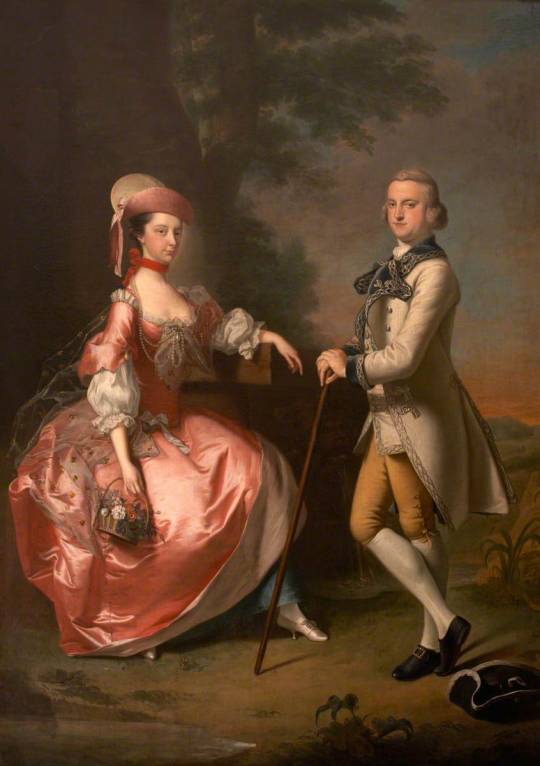
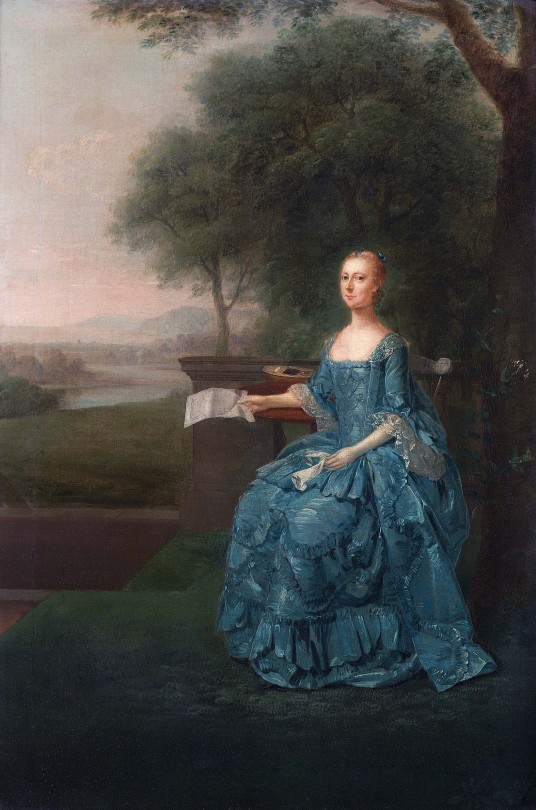
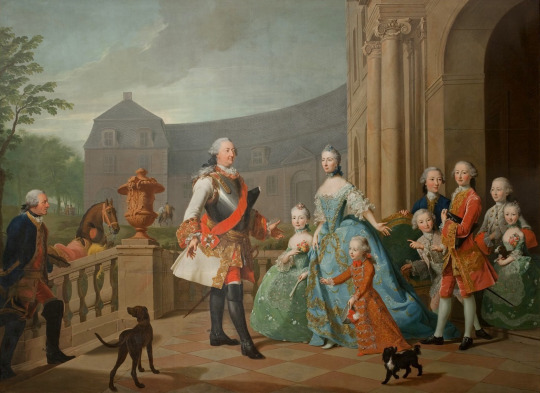
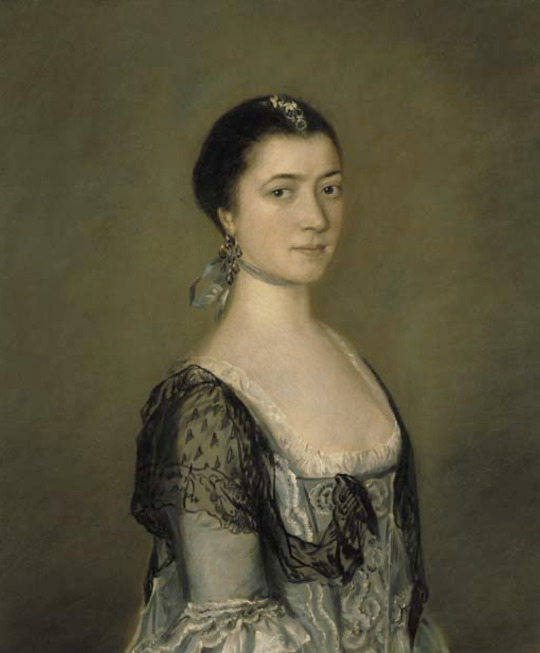
And some 1750s (from top to bottom) -
1755 Sir John Pole, 5th Bt, and Elizabeth Mill, Lady Pole by Thomas Hudson (Antony House - Antony, Cornwall, UK). From Wikimedia 849X1200.
1756 Anne Streatfeild, née Sidney, natural daughter of the 7th Earl of Leicester and wife of Henry Streatfeild by Arthur Devis (auctioned by Bonhams). From their Web site; spots and linear flaws removed with Photoshop 1642X2481.
ca. 1757 Prince Carl of Waldeck-Pyrmont and his Family by Johann Heinrich Tischbein the Elder (Residenzschloss Arolsen - Bad Arolsen, Hesse, Germany). From tumblr.com/history-of-fashion; sixed to screen 1914X1392.
1758 Miss Elizabeth Edgar by Thomas Gainsborough (Christie's - Live auction 6523 Lot 21). From their Web site 1876X2268.
Sarah Harding attributed to John Astley (Museum of Fine Arts - Houston, Texas, USA). From Google Art Project via Wikimedia 1915X2401.
9 notes
·
View notes
Video
2012-10-06_GCR_140 por Mike Brook Por Flickr: The National Railway Museum's SR Maunsell Schools Class 4-4-0 No. 925 (30925) 'Cheltenham' and SR Maunsell King Arthur Class 4-6-0 No. 777 (30777) 'Sir Lamiel', both in Malachite Green SR livery, pass through the fully operational Swithland Sidings at speed on the 'UP' Main line, as they double-head the 2A39, 16:30 Loughborough Central to Leicester North Service on 6th October 2012, during the Great Central Railway's Autumn 2012 Steam Gala.
9 notes
·
View notes
Photo

the robsart family tree ─ c. 1460s to 1560s.
arthur robsart is the illegitimate son of sir john robsart and half brother to amy robsart, countess of leicester.
robert gamage, son of amy robsart and sir christopher gamage of wales, will inherit syderstone hall at the age of sixteen, after the death of his mother in 1565. robert gamage will go onto marry elizabeth kett, niece of the rebel robert kett, in 1572 and they will have two children.
anne gamage, daughter of amy robsart and sir christopher gamage of wales, will marry gideon de vere, son of the earl of oxford, in 1568 after a two year courtship. the marriage was arranged between the countess of leicester and the earl of oxford prior to her passing in 1565.
arthur dudley, 2nd earl of leicester, will be born in 1560. he will quickly be followed by a sister, jane dudley, born in 1561.
5 notes
·
View notes
